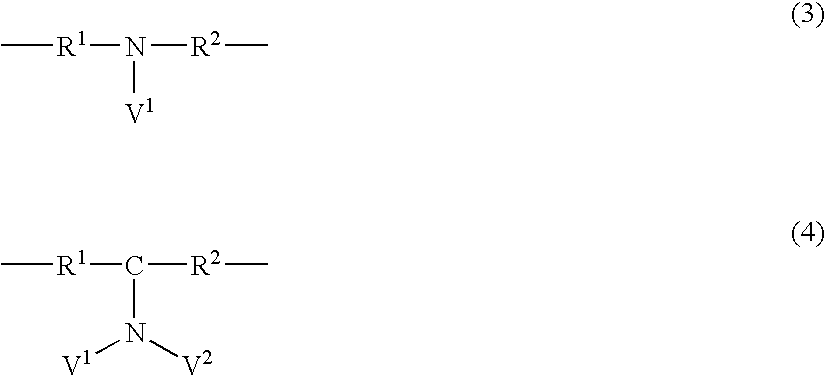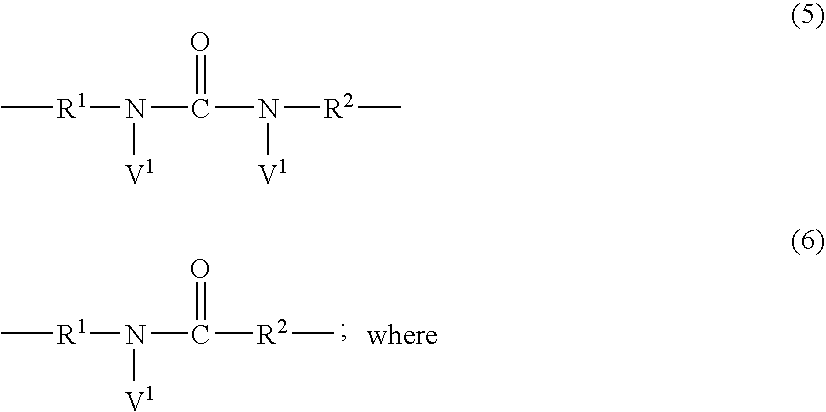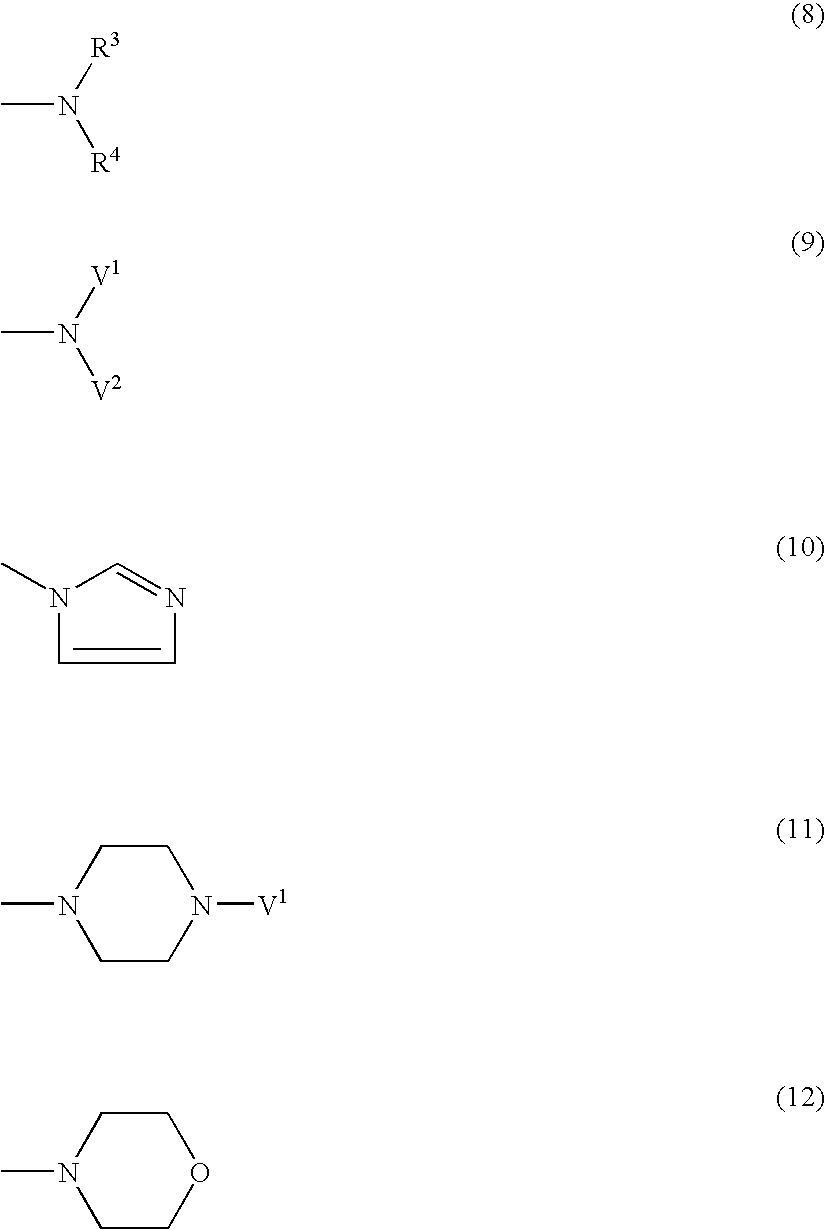Amine catalysts suitable for producing low-emanation, recatalysis-stable flexible polyurethane foams
a flexible polyurethane foam and recatalysing technology, applied in the field of amine catalysts for producing low emanation and recatalysing stable flexible polyurethane foams, can solve the problems of toxicological concern of dimethylformamide and failure of eco tests, and achieve the effect of improving the burning behavior and increasing the recatalysis stability
- Summary
- Abstract
- Description
- Claims
- Application Information
AI Technical Summary
Benefits of technology
Problems solved by technology
Method used
Image
Examples
example 1
[0155]
Formulation100Parts of polyol*14.0Parts of water1.0Part of foam stabilizer*2TEGOSTAB ® BF2370 (EvonikGoldschmidt GmbH)0.2Part of catalyst*3 (EvonikGoldschmidt GmbH)48.3Parts of isocyanate (tolylenediisocyanate T80)(80% of 2,4 isomer, 20% of2,6 isomer)*1= Voranol ® CP 3322, obtainable from Dow Chemical; this is a polyether triol having an OH number of 47.*2= TEGOSTAB ® BF2370, obtainable from Evonik Goldschmidt GmbH; this is a polysiloxane-polyoxyalkylene block copolymer for use as foam stabilizer in the production of slabstock and moulded flexible polyurethane foams.*3= KOSMOS ® 29, obtainable from Evonik Goldschmidt GmbH; this is the tin(II) salt of ethylhexanoic acid.
[0156]The following table shows the type of amine and the foaming result.
Compressionload deflectionRiseFoamCLD, 40%TensiletimedensitycompressionstrengthAmine catalyst[s][kg / m3]Porosity*[kPa][kPa]0.15 part of8925.383.5121TEGOAMIN ®330.15 part8825.483.6107(1.13 mmol) ofTEGOAMIN ®DMEE0.182 part9525.493.6116(1.13 mm...
example 2
Foaming Result—Emanation
[0158]To examine the influence of the amine catalysts diethylaminoethoxyethanol and dimethylaminoethoxyethanol on the foam emanation, a formulation containing a catalyst combination according to the invention and a low-emanation polyol was selected.
Formulation100 Parts of polyol*44.0Parts of water1.0Part of foam stabilizer*2(TEGOSTAB ® BF2370*2) 0.54Part of catalyst*5 (KOSMOS ® EF*5)48.3 Parts of isocyanate (tolylenediisocyanate T80)(80% of 2,4 isomer,20% of 2,6 isomer) 0.15Part of TEGOAMIN ® DMEEor 0.182Part of diethylaminoethoxyethanol*4= Arcol 1105S ®, obtainable from Bayer AG; this is a low-emanation polyether triol*5= KOSMOS ® EF, obtainable from Evonik Goldschmidt GmbH; this is tin ricinoleate
[0159]The emanation behaviour of the above-described foams was examined in accordance with the Daimler-Chrysler test method BP VWT 709 VOC determination (30 minutes at 90° C.).
[0160]This gave the following results.
VOC contentAmine catalystAmine emanationTotal ema...
example 3
Foaming Result—DMF Emanation
[0161]To examine the influence of the amine catalysts diethylaminoethoxyethanol and dimethylaminoethoxyethanol on the emanation of DMF from the foam, a formulation containing a catalyst combination according to the invention and a low-emanation polyol was selected.
Formulation100 Parts of polyol*42.5Parts of water0.8Part of foam stabilizer*2(TEGOSTAB ® BF2370*2) 0.42Part of catalyst*5 (KOSMOS ® EF*5)34.0 Parts of isocyanate (tolylene diisocyanateT80)(80% of 2,4 isomer,20% of 2,6 isomer) 0.50Part of (TEGOAMIN ® DMEE)or 0.61Part of diethylaminoethoxyethanol*4= Arcol 1105S ®, obtainable from Bayer AG; this is a low-emanation polyether triol*5= KOSMOS ® EF, obtainable from Evonik Goldschmidt GmbH; this is tin ricinoleate
[0162]The emanation of DMF from the above-described foams was examined by the test chamber method using a procedure based on DIN 13419-1.
[0163]Samples were taken after 24 hours, and the following results were obtained:
[0164]DMF emanation by t...
PUM
| Property | Measurement | Unit |
|---|---|---|
| Temperature | aaaaa | aaaaa |
| Time | aaaaa | aaaaa |
| Percent by mass | aaaaa | aaaaa |
Abstract
Description
Claims
Application Information
 Login to View More
Login to View More - R&D
- Intellectual Property
- Life Sciences
- Materials
- Tech Scout
- Unparalleled Data Quality
- Higher Quality Content
- 60% Fewer Hallucinations
Browse by: Latest US Patents, China's latest patents, Technical Efficacy Thesaurus, Application Domain, Technology Topic, Popular Technical Reports.
© 2025 PatSnap. All rights reserved.Legal|Privacy policy|Modern Slavery Act Transparency Statement|Sitemap|About US| Contact US: help@patsnap.com



